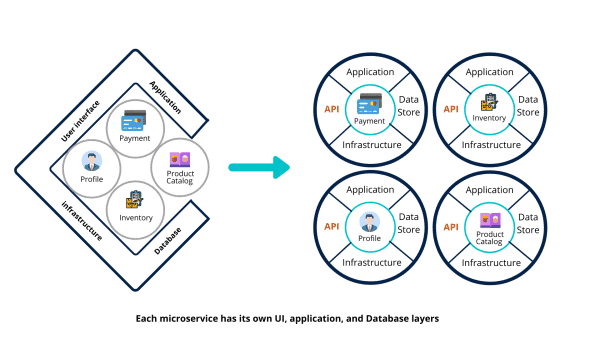The E-commerce applications who still follow monolithic architecture results in being a barrier for innovation. The big brands like Amazon, Netflix, eBay, Google and others have already started using an architectural principle called microservices. In this, the small services are separately developed, deployed and managed and they communicate through standardized APIs.
The monolithic applications contain all the business logic, instead, microservices is a flexible network which can handle all the complexities, therefore, instead of the need to understand millions of lines of code, the developers can work on small operative chunks. The benefits are many.
Firstly let’s understand why monolithic applications are painful for innovation (if you are still on that boat)…
- With the constant technological evolution, the monolithic applications are not easy to maintain. The degree of software complexity keeps increasing as the application tries to keep up with the changing demands.
- In E-Commerce applications large in size, no developer can grasp all the code areas fully which results in lack of ownership. There is a strong constraint in individual developers to touch anything in the application as it could break something.
- There is a lack of agility in the monolithic applications as the teams are structured as per their separate functions. When a change request is made, it affects many areas or teams and QA also take huge time and so adding new features takes too long.
- Monolithic applications are very fragile as the risk keeps increasing with the number of code changes. This happens because of the dependencies built in the system over time.
- As there is a single point of failure in these applications, constant and repeated testing becomes very important. Even if one small part of the application is changed, the entire application needs to be tested and thus continuous delivery becomes impossible also making the Quality Assurance process inefficient.
- Even for the big retailers, it is becoming difficult to keep pace with the increasing transactions taking place online as scaling the application becomes tough with every passing day.
For the companies who feel the need to move faster, microservices is the undisputed solution.
The Microservices-based Approach
The basic idea of microservices architecture is to build small applications with limited functionalities that can be separately deployed. A microservices-based approach encloses each activity of the business as individual services and enables them to interact with each other. Some of the many advantages of following a microservices-based approach are –
- The microservices-based approach reduces software complexity as the scope of single functionality is limited and thus updates and maintenance are easier.
- In the microservices approach, the developer can take full responsibility for their microservice which they have developed or worked on. This approach also enables the developers to have a better relationship with users of their product.
- A cross-functional development team is required to build a microservice who can work on the project separately. The features to be deployed in the application can be done significantly faster and the synchronization efforts are also reduced between the teams.
- If the business application is built on microservices-based approach, then there is no single point of failure. The whole application will not be broken down if anyone service is not responding.
- It is easier to scale the microservices application vertically as they have their own application layers and work separately. Overall performance of the business application is enhanced with microservices being small and independently functional.
- Each microservice application uses a technology stack which is best suited for its own functioning. The developers can choose Java for extensive background calculation services, while for others, lightweight technologies can be used like Ruby or PHP.

Final Words
The businesses with customer-centric strategy need a scalable and flexible software infrastructure to be successful. The microservices-based approach is a resilient solution which can scale as per the organization’s needs. For this approach, you need to break down business functions in independent applications and allow the new features to get deployed quickly by removing any kind of dependencies. By enabling to create, maintain and run microservices, you will be able to scale the business and stay ahead of the competition.
About SynergyTop
SynergyTop is a proud commercetools partner and it’s working towards achieving commercetools vision to help the rest of the industry embrace #MACH with the same passion as the 250+ commercetools users around the world.
SynergyTop leverages all the facility provided by commercetools like Accelerators, Integrators, Merchant Center, and Marketplace etc. to provide seamless commercetools implementations. At SynergyTop, we have a team of best in the industry consultants on microservices, headless commerce experience and cloud solutions. To schedule a no obligation demo, write to us at contact@synergytop.com

















